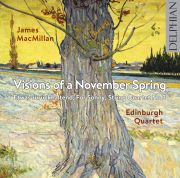|
from the booklet notes to James MacMillan: Visions of a November Spring (Edinburgh Quartet; Delphian Records, 2014):
Like the Missa brevis (composed in 1977 but not prepared for publication and performance until 2007), or the two orchestral works – Symphonic Study (1981) and The Keening (1986) – similarly rediscovered and given belated premieres in January 2014, Etwas zurückhaltend was composed before MacMillan’s professional career had begun, and unearthed only when the composer was nearly fifty and internationally famous. Writing before the work’s premiere in 2010, MacMillan explained that it
was written in 1982 when I was a student of John Casken’s at the University of Durham. The piece was forgotten until last year, when I realised that there was a lot in its ideas which seemed current and relevant to my recent work. The title comes from Wagner’s indication for the final pages of Götterdämmerung, and the work reflects an ongoing interest in this composer, which has been reflected at various points since in my own work.
We’ll come back to those ‘reflections’. For now let’s follow MacMillan’s account, amplifying as we go …
The work opens with a static, floating music which accompanies little fragments of increasingly expressive phrases on the first violin. This builds towards a series of outbursts of pizzicatos and arpeggios before the music heads off into more mysterious territory.
What must have been at the centre of the composer’s mind in 1982, even if he did not mention it twenty-eight years later, is the remarkable harmonic structure of that ‘static, floating’ opening. Starting from a simple pattern of stepwise movement split between the three lower instruments – all playing together, muted and senza vibrato, in a close middle register – MacMillan gradually opens out the chromatic space of an octave from B below middle C to B flat above it. The sixth pitch is added in bar 8, and the seventh in bar 9. By bar 15 all twelve chromatic pitches are in play and yet each of the instruments involved only ever plays four pitches, fixed in register (that same middle octave). The pitch-space is simultaneously saturated and stratified.
This radical arrangement of harmony and texture continues for a full two-and-a-half minutes, with tension increased by a gradual rhythmic acceleration; and then, after a scurrying pizzicato interruption for all four instruments, the three lower parts resume it again for another minute and a quarter, now decelerating back to the slow rhythmic values of the opening. For the best part of four minutes each of them has only played four different notes. What the first violin has been preparing in that time is something equally radical, but far less abstract – or abstract in a different way. It is something that even the most attentive listener is unlikely to be aware of on a first hearing, although if on reaching the end of the piece one were to go back and immediately listen again, the shape adumbrated by the first four high notes at 0:45 – or again by those at 3:12, after the pizzicato interruption – might already have come to seem pregnant with associations that are made more explicit later in the piece. But on a first hearing the listener’s ears will probably first register something unusual around 4:23, when, finally unmuted, the first violin plays a three-bar melody which soars upwards and then descends into a strangely familiar-sounding cadence.
It is, in fact, the ‘Fate’ motif from Wagner’s Ring. If it has a symbolic meaning here, it is an opaque one. Perhaps MacMillan was remembering the use of the same motif in the finale of Shostakovich’s then recent Symphony No 15; perhaps not. In any case, having heard this relatively explicit quotation the listener may go on to notice other motifs from The Ring: such as a hint of Magic Fire in ghostly high cello harmonics at 5:50, joined by viola at 6:02 and then in the three upper instruments (all in harmonics) at 6:15. By the time of the long, expressive cello solo starting at 8:09, this latter motif – alternating a semitone and a whole tone above the main held pitch – seems entirely assimilated into the quartet’s own instrumental style, although MacMillan makes no attempt to disguise the source. Indeed, throughout the piece there is no clear boundary between quoted and original material, as is perhaps most spectacularly apparent from 11:33, when a Shostakovichian organ-grinder-like passage is topped with a melody again drawn from The Ring. This time it is the ‘Redemption through Love’ motif – the very motif whose appearance in the closing pages of Götterdämmerung, the final part of Wagner’s immense tetralogy, carries that expression mark which MacMillan takes as his title. (The same motif is surely also, albeit to very different effect, the deliberate point of reference for the ‘I Have a Love’ theme in Bernstein’s West Side Story.)
The hushed, slow passage that follows is again cadenced using the ‘Fate’ motif (at 13:17 and again, after a cello interjection, at 13:31). From here, to quote MacMillan again:
A rhythmic and energetic Allegro eventually establishes itself which rushes towards a frantic and free climax. The work ends with a tentative and tense coda, with nods still being made in the direction of The Ring’s final Immolation Scene.
From 17:31 the Redemption melody is heard in full and with its original harmonies, radiant but halting, its texture broken into by odd pauses and the melodic line displaced, with notes appearing in the wrong octave: the continuity not so much disguised as audibly undermined. The work ends inconclusively, as if something else were waiting to start but not yet quite ready.
© 2014 John Fallas
for more information, to reproduce any material from this website, or to commission new articles or programme notes, please contact jfallas @ worldisnow . co . uk (no spaces) |
|


|